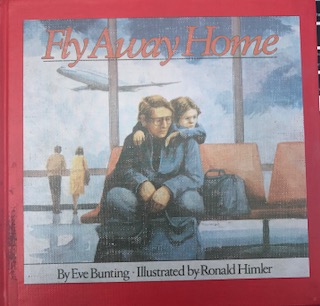
Title: Fly Away Home
Author: Eve Bunting
Illustrator: Ronald Himler
Publisher: Clarion Books
Year: 1991
Number of Pages: 32
Tags: Emotion, Family, Fiction, Picture Book, K-1, 2-3, Taylor Krueger
Genre: Fiction Children’s Book
Analysis: This book shares the story of a father and son who are homeless and live in the airport. They have one rule of living that they follow: “don’t get noticed,”. The young son has multiple questions of what life is like outside of the airport, as he wants to go back to the days before his mother died. His father works on the weekends to support his son and hopefully have enough savings to move out of the airport. The father and son share their daily routines and experiences that make up their life. At the end of the day, the son knows his father is providing the best he can for his family.
The illustrations of this book are bordered by the edge of the page. The illustrations are fuzzy and allow the character of the brushstrokes to show. The visible brushstrokes gives the images depth and an interesting perspective for the reader. The reader is present in the illustrations as they are viewing the actions of the characters from afar. The illustrations  allow the reader to peer through a window into the lives of the characters as their experiences may be different than many other people. The images share the emotions and worries of the characters with the reader as there is a connection through the illustrations.
allow the reader to peer through a window into the lives of the characters as their experiences may be different than many other people. The images share the emotions and worries of the characters with the reader as there is a connection through the illustrations.
The colors used throughout the book are sad and dark which give insight into the emotions of the characters. The colors are mainly blue, which could represent the sadness of the young son as he wonders what life would be like outside of the airport. He wants to fly away like the bird he saw by the window in the airport. The use of brushstrokes is apparent in the illustrations giving the images depth and a greater interest from the reader.
There are multiple emotions that are shown through the facial expressions of the characters. The structure of the characters are depicted through the illustrations and elaborate the text. Throughout the book the young son is shown to have the expressions of sadness and happiness. He is perceived to be sad when he explains the current living condition of himself and his father at the airport. He wants life to go back to the way it was before his mother died, but he knows that will not happen for quite some time. He is perceived to be happy when he explains his friendship with Denny and the future he can have once his father saves enough money to buy an apartment. The main characters are shown to be smaller than the surrounding people in the illustrations. This could be because of the lack of power they have in the crowds of people as they are homeless, or it could represent their rule of not being noticed.
The illustrations and text of the book represent an ideological issue for the reader. Throughout the book homelessness is present as it shows the struggles families have through this experience. It shows how real this issue is in our country and shares the story of a family going through this devastating state. The ideology of this book sends a strong message to the reader as it is often unknown to many young children the effect homelessness has on families.
This book is a representation of a multimodal text as the words and illustrations work together to fill in the gaps for the reader. The text and illustrations enhance the message and important meaning of the book. The images are visual representations of the words and allow the reader to further understand the theme of homelessness. This book uses the images and text to send a strong message to young children.
